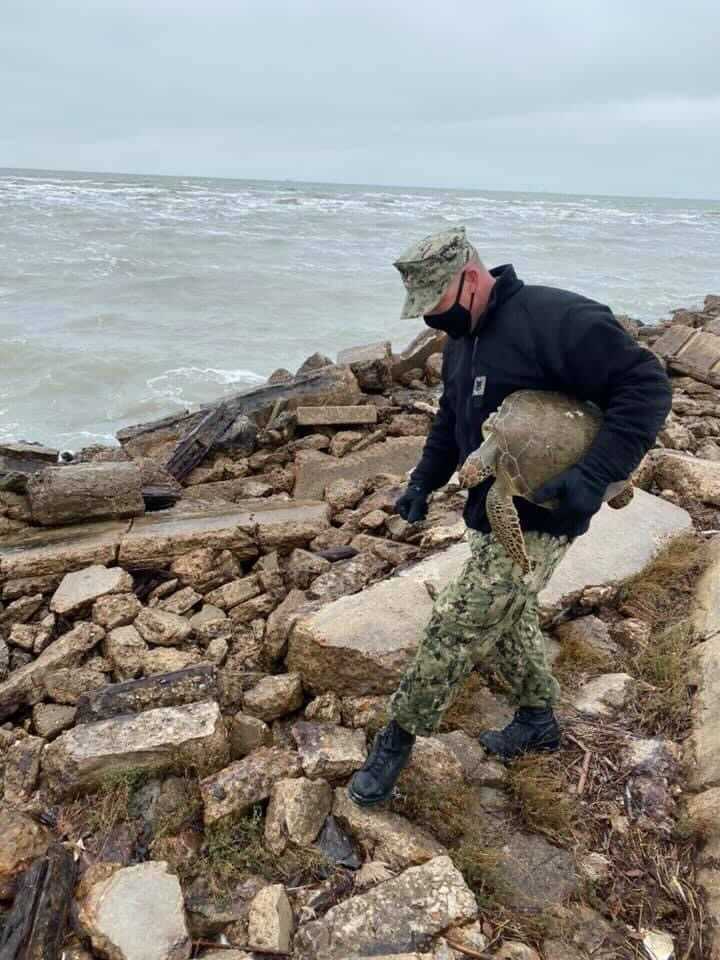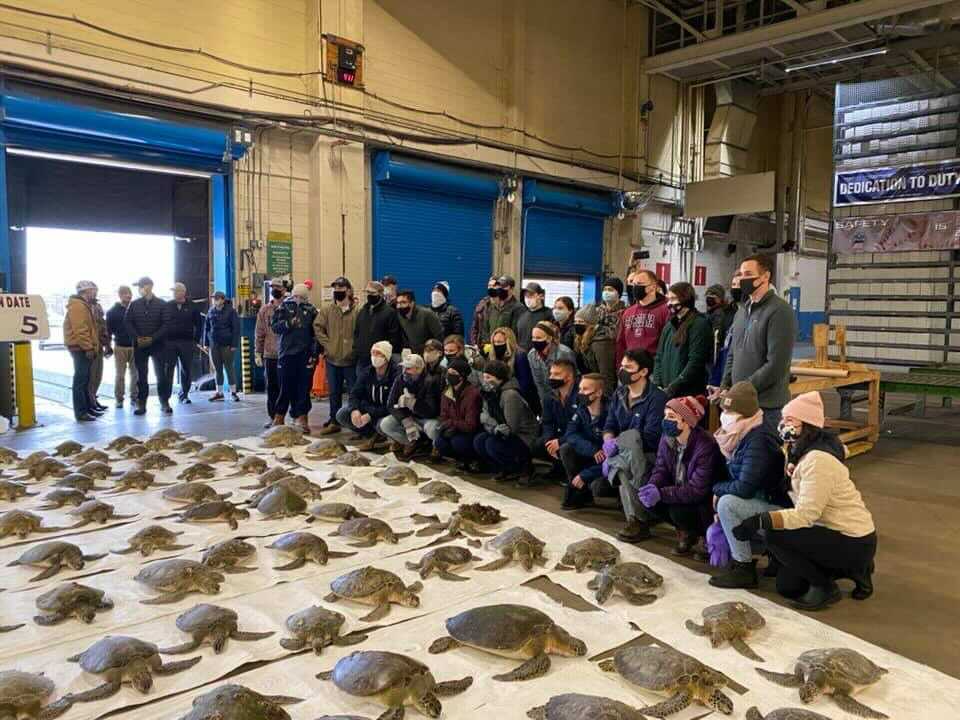
Texas recently experienced record-breaking cold temperatures, causing the largest cold-stunning event for sea turtles in the state’s history. As the water temperate dropped to the mid-30s Fahrenheit, thousands of turtles were found stranded on beaches or floating in the water.
In the shallow bays and inlets of the Laguna Madre next to Padre Island, water temperatures can change rapidly. As reptiles, turtles are cold-blooded and cannot regulate their body temperature. Cold-stunned turtles experience hypothermia when the sea water drops to about 50°F or below, and become lethargic and unable to swim.
According to Sea Turtle Inc., a non-profit organization on South Padre Island, “cold-stun events happen when the water gets too cold for sea turtles to maintain their body temperature. As a result, the turtles are awake but unable to move or swim. If not rescued, while they are awake and alive, the turtles will drown from being unable to lift their head to draw their breath.”
Fortunately, the Coast Guard and Navy were ready, willing and able to join in the effort with a team of organizations to help the turtles.
A consortium of organizations including the Turtle Survival Alliance, Sea Turtles, Inc., the Gladys Porter Zoo in Brownsville, the Texas Sealife Center, Texas Department of Parks and Wildlife and the National Park Service make up the South Padre Island Sea Turtle Stranding and Salvage Network, which works to rescue and care for cold-stunned turtles. While the area has experienced cold weather before, the February 2021 cold weather event was unprecedented. With 7,000 or more turtles knocked out by the frigid waters, ranging in size from a few pounds to more than 400 pounds. The rescuers were overwhelmed.
Active-duty Sailors, Marines and Coast Guardsmen pitched in, including student pilots for Naval Air Station Corpus Christi. Volunteers also included Navy civilian employees, retirees, spouses and family members.
NAS Corpus Christi and Coast Guard Sector Corpus Christi, like many military installations, are used to encountering wildlife suffering from severe weather. But this 2021 event has resulted in thousands of turtles stupefied by the cold. It is remarkable that so few of them died, but without the intervention of the Navy, Coast Guard and others, the toll would have been much higher.
Capt. Christopher Jason, the commanding officer of Naval Air Station Corpus Christi, used his kayak to paddle out to the turtles and pull them out of the water. Turtles were kept in a hanger and later moved to a Defense Logistics Agency temperature-controlled warehouse to recover.
The rescues started with a base resident wanting to help a couple of injured birds. It turned into a large-scale operation involving dozens of volunteers rescuing more than 1,200 threatened sea turtles, at the same time as many of those volunteers did not have heat or water because of the unusually cold winter storm.
“The scale of the effort was unprecedented,” said Biji Pandisseril, NASCC environmental director. “Usually, about 20 to 30 turtles are rescued here after a cold snap.”
U.S. Coast Guard Rescue swimmers from Air Station Corpus Christi swam through rough and cold water to reach turtles far away from the shore. Petty Officer 3rd Class Will Groskritz and Petty Officer 2nd Class Russell Grizzard brought 60 turtles to safety in one day. The next day, Grizzard and Petty Officer 1st Class Rob Rendon saved another 40 to 50 turtles.
Responding to cold stun events is one of Sea Turtle Inc.’s ongoing rescue and rehabilitation efforts. For example, Sea Turtle Inc. has released over 55,000 sea turtle hatchlings into the Gulf of Mexico, and each year helps with any cold-stunned turtles that are found. But, with more recued turtles coming in the Sea Turtle Inc.’s facility could handle. The rescued turtle filled the facility to capacity, with many turtles placed in children’s play pools. A makeshift rescue center was established at the South Padre Island Convention Center and Visitors Bureau.
In addition to the turtles being affected by the cold, their rescuers also had to contend with power outages and water shortages of their own as the cold snap surprised Texans.
Aerospace Company SpaceX donated a large power generator from their Boca Chica launch facility in Brownsville to provide electricity to the Sea Turtles Inc. facility, which already had hatchlings and other turtles being cared for. The power helped to keep the water in facility’s tanks warm enough for the turtles to survive.
“This event had the potential to be devastating to both the sea turtle population and our hospital and residents. We prepare for cold stun events, but to respond as efficiently as we have although the additional challenge of no power speaks volumes about the passion and commitment of the Sea Turtle Inc staff and the Rio Grande Valley community,” said Wendy Knight, executive director of Sea Turtle Inc.

Unique ecosystem
Dr. Donna Shaver, chief of the division of sea turtle science and recovery with the National Park Service at Padre Island National Seashore, is the Texas coordinator of the Sea Turtle Stranding and Salvage Network.
Shaver and her team were not completely unprepared. Back in October, Shaver, along with Texas State Aquarium and U.S. Coast Guard representatives, held a tabletop exercise to discuss what the response to a mass cold-stunning event such as this would look like. Because of the planning and preparation of that exercise, rescue, rehabilitation, and release of these animals was swift and effective.
Shaver said the February cold snap was the coldest event since 1895, when a cold-stunning event was thought to have decimated the Green Sea Turtle population in Texas. She called it the “perfect storm” for cold study.
Shaver explained that the Laguna Madre, the salt water lagoon between mainland Texas and Padre Island, with lush sea grasses and algae, is a prime habitat for the juvenile green turtles, which represent the vast majority of the cold-stunned turtles.
Once-numerous, the green sea turtle is today a threatened species in Texas. Considered a delicacy, there was once a large commercial fishery harvesting turtles in the area. “This used to be a thriving population in Texas until it was decimated in the late 1800s. It’s rebuilding, but now needs our help with these rescues,” Shaver said.
At about 125 miles long, Laguna Madre is one of the few hypersaline lagoon systems in the world, meaning it is saltier than most seawater. There isn’t much inflow of fresh water or rainwater, and circulation with the Gulf of Mexico is limited. Laguna Madre is one of the most productive estuarine systems and a valuable habitat for wildlife. It is protected by Padre Island, the longest stretch of undeveloped barrier island in the world, and there are only a few channels that allow access to open water. The precipitous decline of the temperatures, how long it stayed cold, and the depth of the cold water spelled trouble for the trapped turtles.
The water temperature can change temperature rapidly, and sea turtles swimming in Laguna Madre may not have had enough time to swim out of to the deeper, warmer waters of the Gulf of Mexico before becoming cold stunned.
Rehabilitation is fairly straight forward, Shaver said. “The first step is to bring in them in out of the elements and gradually warm up — but not too quickly — and then determine which ones are still alive, because we can’t tell for many of these turtles.”
“When they start to move around, we can put them in the water, let them expel some gas, and give them a swim test. Then we wait until the Gulf of Mexico waters when the waters are warm enough so we can release them there,” Shaver said. “We don’t want to release them back into the Laguna Madre, because they could become cold-stunned again.”
“Working with our partners in the Texas State Aquarium and Texas Game Wardens to release these animals back into the wild is a surreal experience,” said Coast Guard Ensign Austin Sawicki. “Getting to play a small part in keeping the green sea turtle population safe is a very rewarding experience.”
Coast Guard Sector Corpus Christi and Station Port Aransas crewmembers assisted partner organizations to release the rehabilitated sea turtles back into the Gulf of Mexico in areas where the water was at least 55 degrees Fahrenheit were selected.
- A Day to Remember - September 11, 2023
- Indo-Pacific Maritime Security Exchange will examine emerging capabilities and capacity - July 12, 2023
- Cold Waters Spark Warm Relationship - April 20, 2023






